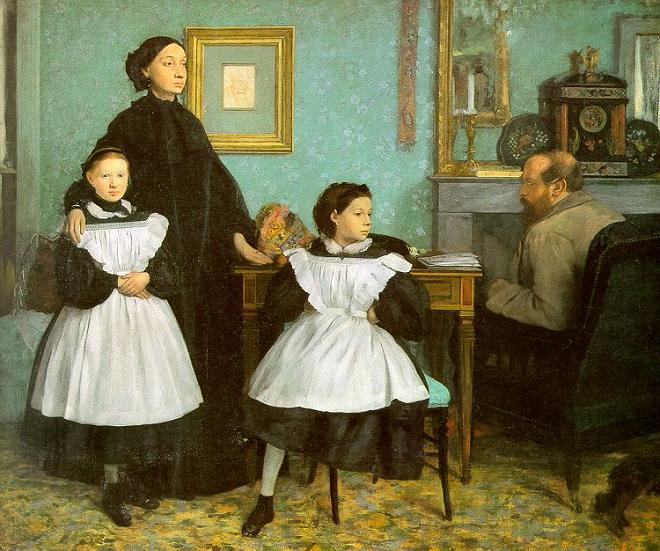Particular circumstances of individual relationships in all their psychological subtleties fascinated a young Frenchman who painted a family group about 1860 when he was not even thirty years old. But at that age Edgar Degas was already an urbane cosmopolite. …
Degas was a doubter, a speculator upon human nature, and basically a pessimist. In his family there was a less happy state of affairs than the standard pre-Freudian pretense of family life being a stylistic pretense of agreeable surfaces and conventions of the tepid experience in life. It is quite possible that Degas’s The Bellelli Family is one of the finest psychological group portraits ever painted. The temperaments are individualized and their interrelationship is revealed with all the intensity, friction and conflict that would arise on the dawn of modernism.

—But of all of Degas’ paintings revealing modernity with all its concurrent problems, it’s the family portrait’s that I find the most mesmerizing. There is something so disturbing about the discordance and the disconnect that is so palpable in his family portrayals. The protagonists are usually looking in opposite directions, barely touching with solemn, melancholy expressions. —click image for source…
In Degas’s portrait the father is separated from the rest of the family by a series of vertical lines that, violating all accepted compositional rules, separate a generous third of the picture from the rest of it. Also, he sits unconventionally with his back toward us, and he is painted less decisively than the other figures: he is the only one not completely revealed to us as a person and we are left with the feeling we do not know him as we know the mother and daughters. He is an outsider.
However, the father’s vagueness and isolation are reversed in the figure of the wife who stand with decision, dignity and forbearance. Of all the figures hers is the simplest and strongest in silhouette,and may be why we return to her always, no matter how interesting the other figures may be in their greater detail and variety.
It is apparent that Degas set about expressing a specific set of circumstances with the help of appropriate compositional means. It is a great picture because it is expressive whether we are aware of the family dynamics and circumstances or not. It has a life of its own beyond the immediate reasons for its creation.
The painting’s greatness lies in its ability to stir us to thought beyond the lmited considerations of a single family’s not unusual circumstances. Degas crystallized the material into an order that results in a clarity to which our sensibilities and understanding can depart from an expand upon. Degas invented compositions without direct precedent, without a obvious formula, and with devices running counter to tradition in a way that was unsettling to more conventional artists.
ADDENDUM:
(See link at end)…Some of the symptoms of capitalism that appeared during the new modernized period include an increase in commerce and entertainment industries, as seen in Impressionist-era works of artists such as Edouard Manet and Edgar Degas. Specifically in their paintings of cafés, one of the many new contrivances for the modern lifestyle, Manet and Degas were not only painting images of modern society, but they were also painting scenes of social stratification, specifically the working class. Put plainly, as they were painting the urban scenes they saw before their eyes, they were also capturing features of capitalism at hand….
Ultimately, however, Manet and Degas’ paintings should not be misconstrued as paintings done with an objective, “Impressionist” eye. Rather, each painting suggests the perspective of a distinctly upper class member of bourgeois society. A premiere art critic and lyrical poet during the Impressionist era, Charles Baudelaire trumped the image of the flâneur, whom he fundamentally describes as a “man of the world.” The flâneur is an empowered bourgeois male, who “rather consciously emulated the British aristocrat and gentleman” (Herbert, 24). This “man of the world” is the presupposed man of exemplary genius entrusted to convey the “moral and aesthetic feeling of their time;” it is the “flâneur, the passionate spectator…a prince,” who is the artist (Baudelaire)Read More:http://hearthouse.wordpress.com/tag/edgar-degas/





 COMMENTS
COMMENTS